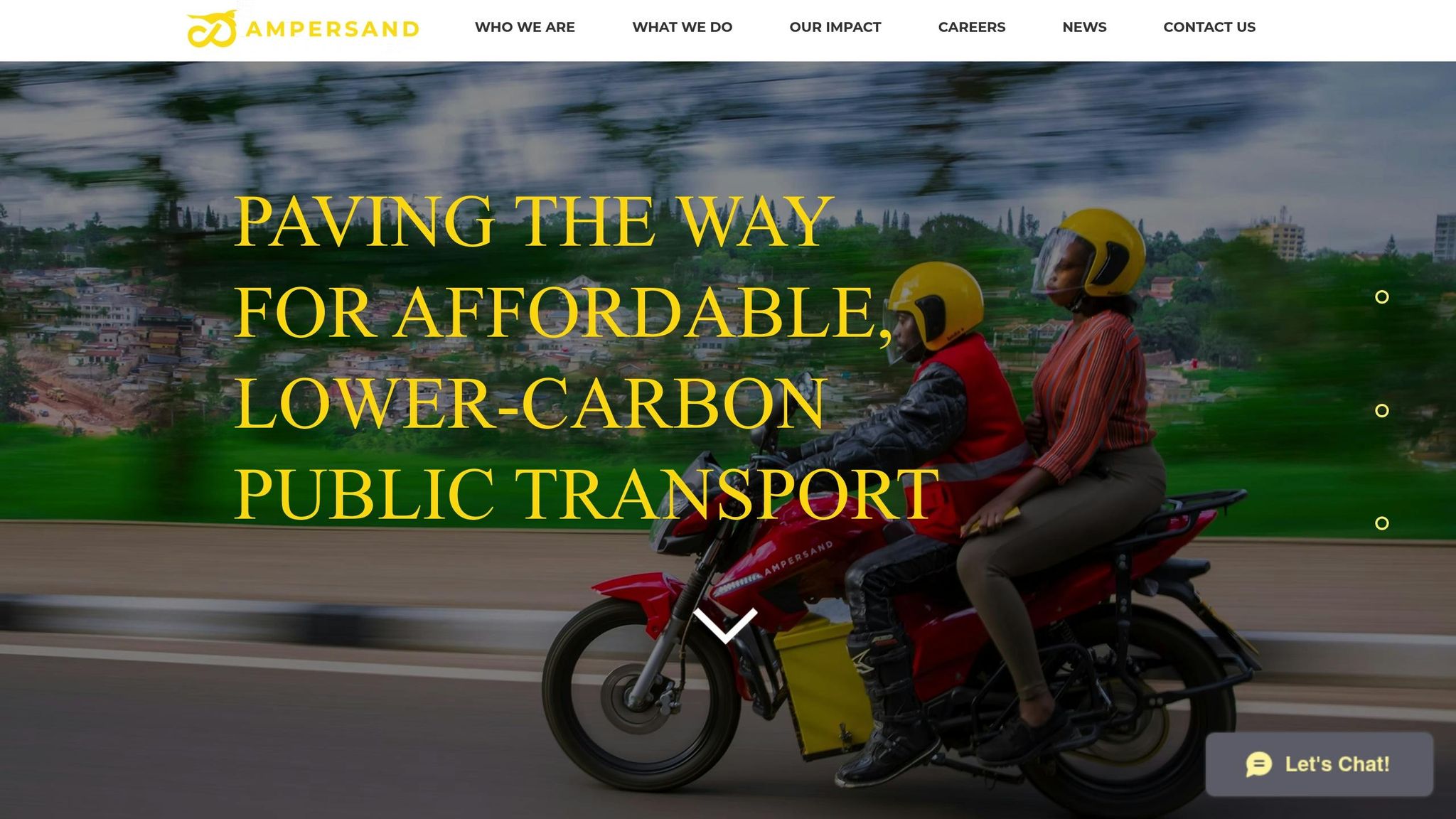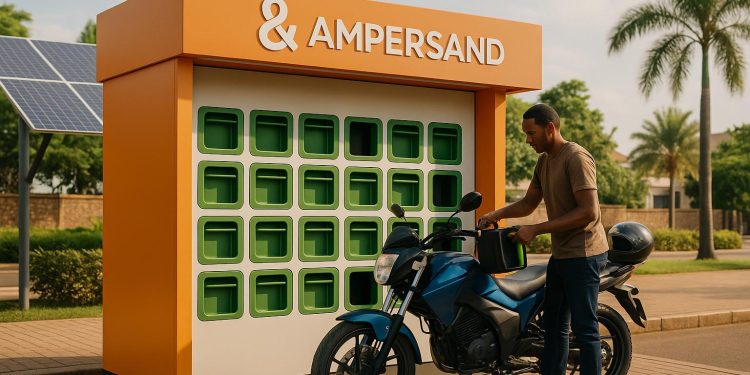Ampersand has secured $21.5 million to expand its electric motorcycle and battery swap station network across East Africa. This funding, backed by investors like AHL Venture Partners, Everstrong Capital, and Beyond Capital Ventures, positions the company to scale its operations in Rwanda, Kenya, and beyond. Here’s what you need to know:
- Funding Purpose: Ampersand will use the funds to grow its battery swap station network, increase e-motorcycle production, and expand into new markets like Tanzania and Uganda.
- Cost Savings: Ampersand e-motorcycles are 45% cheaper to operate than gas-powered bikes, saving riders around $700 annually.
- Environmental Impact: Each e-moto reduces CO₂ emissions by 75–95%, with the fleet already avoiding over 12,000 tons of emissions.
- Battery Swap Efficiency: Riders can swap batteries in under two minutes for about $1.60, eliminating long charging times.
- Growth Goals: By 2030, Ampersand aims to deploy 600,000 e-motorcycles and support 1 million vehicles with battery swap stations.
Ampersand’s efforts align with Rwanda’s clean energy policies, which include tax exemptions for electric vehicles and subsidies for riders. Challenges like supply chain issues and funding gaps remain, but partnerships with companies like BYD and TotalEnergies are helping to address these hurdles. The company is on track to reshape urban mobility in East Africa, with plans to deploy 5 million e-motorcycles by 2033.
Ampersand Intro

How Ampersand’s Battery Swap Stations Work
Ampersand’s battery swap system changes the game for e-moto riders. Instead of spending hours charging batteries, riders can swap out their drained batteries for fully charged ones in under two minutes – delivering the perks of electric transportation without the wait.
Battery Swap Process
The swap process is quick and straightforward, taking just four steps to complete in under two minutes. Riders first purchase or lease an Ampersand e-moto and use the Ampersand Driver App to keep an eye on battery levels. When the charge runs low, the app guides them to the nearest swap station. At the station, the depleted battery is exchanged for a fully charged one, and the transaction – about $1.60 per swap – is completed digitally.
"Riders easily swap depleted batteries for fully charged ones at our battery swap stations, minimizing downtime", says Alp Tilev, CTO and co-founder of Ampersand.
This streamlined process eliminates the need for long charging waits, ensuring riders can stay on the move with minimal interruptions.
Rider Benefits and Cost Savings
Ampersand’s system doesn’t just save time – it saves money too. Riders see significant cost reductions, with annual energy savings of around $700. This translates to a 45% boost in net earnings compared to gas-powered motorcycles. In Kigali, for example, riders can earn up to $23 a day – a 35% increase over the income typically generated by petrol bikes. Operational costs are 35–40% lower, while ride fares are 10–20% cheaper than traditional services.
Take Numukobwa Dative, a rider in Kigali, who financed her e-moto for $2,100 through Ampersand. Thanks to the system, she now enjoys higher daily earnings.
Current Operations and Numbers
Ampersand’s battery swap network is growing fast, covering Rwanda and Kenya with impressive results. The company handles nearly 18,000 battery swaps and recharges daily, with more than 14,700 swaps happening in Rwanda alone. Across the two countries, over 5,700 e-motos are part of the network – 4,000 of which operate in Rwanda – collectively traveling about 950,000 kilometers (590,000 miles) every day. To support this, Ampersand has set up 25 strategically located swap stations, and its battery management platform boasts a 99.72% uptime.
"Our made-in-Africa battery fleet already leads the world in cost per kilometer and uptime for light-electric vehicles".
This high level of efficiency not only keeps riders productive but also strengthens Ampersand’s mission to create sustainable and affordable urban mobility solutions.
Environmental and Economic Impact
Ampersand’s recent funding and expansion efforts are doing more than just advancing electric transportation – they’re reshaping Rwanda’s environmental and economic landscape. By rolling out a growing network of battery-swapping stations for electric motorcycles, the company is cutting carbon emissions and unlocking financial opportunities for the region. With thousands of battery swaps happening daily, the impact is measurable and growing.
Carbon Emission Reductions
Ampersand’s electric motorcycles are making a noticeable dent in carbon emissions. Each e-moto prevents between 2.0 and 2.6 tons of CO₂ emissions annually, representing a 75–95% reduction compared to traditional petrol motorcycles, which emit about 11.78 kg of CO₂ per 100 kilometers.
So far, Ampersand’s fleet has traveled over 280 million kilometers (174 million miles), avoiding more than 12,000 tons of carbon emissions. With over 5,700 e-motorcycles now operating in Rwanda and Kenya, these reductions are steadily increasing.
"Depending on what the grid mix is [the proportionate shares of a power grid’s energy sources], our e-bikes eliminate 75% to 100% emissions of greenhouse gases every year", says Josh Whale, CEO of Ampersand.
In Rwanda, where transportation accounts for 13% of national emissions, scaling up to 600,000 e-motorcycles by 2030 could significantly slash the country’s carbon footprint.
Solar Power and Clean Energy Use
In 2024, Ampersand took a major step toward clean energy by partnering with CrossBoundary Energy to power its battery swap stations with solar energy. A 37kWp solar pilot in Nairobi highlights this effort, aligning with Rwanda’s goal of generating at least 60% of its electricity from renewable sources by 2030.
Rwanda’s high solar potential – some areas receive up to 1,890 kWh per square meter annually – makes solar charging efficient. The country is already home to East Africa’s first utility-scale, grid-connected solar plant, a 5MW facility in Rwamagana. Ampersand also draws on hydroelectric power from national grids, further reducing the carbon footprint of each battery charge.
Local Economic Benefits
Ampersand’s initiatives are not just benefiting the environment – they’re energizing Rwanda’s economy. By creating jobs and reducing costs for riders, the company is strengthening local industries and improving livelihoods. Ampersand employs over 300 people and assembles 100 e-motorcycles and 140 batteries weekly, building local expertise in e-mobility.
For riders, the switch to electric motorcycles brings substantial savings. Annual fuel and maintenance costs drop significantly, boosting net earnings by 45%. On average, e-moto riders in Rwanda spend just 60% on electricity compared to what they would spend on gasoline.
Ampersand’s financing model also makes electric motorcycles more accessible. By separating battery costs and offering pay-as-you-go battery swaps, the company enables finance providers to offer lower interest rates. As CEO Josh Whale explains:
"The net result is that customers benefit from lower interest rates and the cost of the bike ends up being the same or even cheaper than the conventional petrol bike".
With over 18,000 battery swaps happening daily across Rwanda and Kenya, the ecosystem is creating jobs for technicians, station operators, and other support roles. As Ampersand works toward its 2030 goals, this combination of environmental and economic benefits is poised to transform Rwanda’s transportation sector into a driver of sustainable growth.
sbb-itb-7bc66b5
Rwanda’s Clean Transport Policies and Support
The Rwandan government has emerged as a trailblazer in Africa’s electric mobility space, thanks to a forward-thinking policy framework that encourages initiatives like Ampersand’s. With ambitious climate targets and well-structured incentives, Rwanda is reshaping its transportation sector, making it a prime destination for electric vehicle investments. This supportive environment has unlocked opportunities for targeted financial and operational programs.
Government Incentives for Electric Vehicles
To make electric motorcycles more accessible, the government has rolled out financial incentives, including a 0% import duty on e-motorcycles. This exemption, renewed annually since 2024, aims to accelerate the shift away from gas-powered vehicles. Additionally, the Ministry of Finance and Economic Planning has implemented a tax policy that exempts pure electric vehicles while taxing hybrid cars. This approach discourages outdated hybrid technology and promotes cleaner alternatives. Companies in the e-mobility sector also benefit from a reduced corporate income tax rate of 15%, as facilitated by the Rwanda Development Board (RDB).
DG Byiringiro, Director General for Transport at the Ministry of Infrastructure, highlighted the importance of these measures, stating:
"The incentives will also play a role to mobilize investment into the e-mobility sector which has fast emerged as a top sector on demand."
The government has also introduced initiatives aimed at improving affordability for riders. The E-Moto Rebate Scheme, running from 2025 to 2030, provides subsidies to help low-income and female operators reduce down payments on electric motorcycles. This $17.8 million program, developed in partnership with the Rwanda Green Fund and the Development Bank of Rwanda (BRD), directly addresses cost barriers. On top of these efforts, the government has removed a significant hurdle for businesses by offering rent-free land for charging stations, enabling the expansion of battery swap networks.
Role in Rwanda’s Auto Market Growth
These incentives do more than lower costs – they are driving a transformation in Rwanda’s automotive market. Ampersand’s growth aligns with the country’s broader goals, including reducing emissions by 38% between 2015 and 2030. Given that taxi motorcycles accounted for roughly 32% of total road traffic emissions in 2021 – equivalent to 427.45 gigagrams of CO₂ – transitioning to electric motorcycles directly addresses a major pollution source.
As of March 2024, Rwanda had around 4,800 electric motorcycles in operation, a small but growing portion of the overall motorcycle fleet. In collaboration with the United Nations Development Programme, the government is gradually phasing out traditional gas-powered motorcycles in favor of electric models.
Challenges and Future Plans
Ampersand is navigating a complex path toward expansion, balancing strong demand with persistent hurdles like funding shortages and supply chain disruptions. To meet its ambitious growth goals, the company needs to address these operational challenges and scale its infrastructure to keep up with increasing rider demand.
Current Obstacles
One of the biggest challenges Ampersand faces is securing enough capital to sustain its growth. CEO Josh Whale candidly shared:
"We are a growing company and we need to raise funds and capital for growth".
The demand for Ampersand’s electric motorbikes is overwhelming, with over 9,000 drivers waiting for bikes – far exceeding the company’s production capacity. Global supply chain issues, worsened by the pandemic and the Russia–Ukraine conflict, have driven up the costs of materials and components needed for assembly. Operation coordinator Kevin Mucyo explained:
"The pressure is that we have too much demand for motorbikes now that it is outstripping supply. We don’t have enough money to produce the batteries and motorbikes".
Adding to the challenge, Whale noted that many climate-focused venture capital firms prefer to invest in established, low-risk technologies rather than newer innovations:
"Climate venture-capital firms tend to sit on the fence and invest in already stable, low-risk technologies, rather than (in) new tech".
To tackle these issues, Ampersand is diversifying its revenue streams by selling batteries to companies building charging networks and partnering with energy infrastructure firms to create subsidiaries that spread financial risks. The company is also exploring local manufacturing for certain components to reduce reliance on offshore production. These efforts are paired with accelerated expansion plans and strategic collaborations designed to overcome these obstacles.
2030 Growth Targets and Expansion
Ampersand has set its sights on deploying 600,000 electric motorcycles by 2030 and scaling up to 5 million by 2033 across East Africa. The company’s regional expansion plans include entering markets like Tanzania and Uganda.
Strategic partnerships play a critical role in addressing challenges while driving growth. Collaborations with companies such as TotalEnergies and CrossBoundary Energy are fast-tracking infrastructure development, while financing partners like M-Kopa, Watu, and Jali Finance are enabling riders to purchase motorbikes through affordable 24-month payment plans. A significant milestone was achieved in June 2024 with a partnership with BYD. This deal will allow Ampersand to purchase advanced battery cells from BYD to produce around 40,000 electric motorcycles by the end of 2026. Speaking about the partnership, Whale remarked:
"This partnership marks a major milestone for Ampersand as we continue to lead the charge in providing sustainable, cost effective, mass-market EV solutions".
Ampersand is also fostering collaboration within the electric vehicle sector by inviting other EV brands to use its infrastructure, reinforcing a cooperative approach to advancing clean mobility. Reflecting on recent investments, Whale highlighted their impact:
"This additional investment will accelerate the rollout of our EV energy technology and infrastructure to the mass market, bringing us closer to our goal of deploying 5 million electric motorcycles by 2033".
Currently, Ampersand’s commercial motorcycle fleet covers an impressive 3,000,000 kilometers (approximately 1,860,000 miles) every week in Kigali and Nairobi, showcasing its operational scale.
Battery Swapping vs. Traditional Charging Comparison
Ampersand is leveraging battery swapping as a key strategy to reduce downtime compared to traditional charging. This approach is particularly well-suited to commercial operators who rely on high vehicle utilization rates to maximize income. The global battery swapping market, valued at approximately $1.7 billion in 2022, is expected to grow to $11.8 billion by 2031, with an annual growth rate of 23–30%.
Here’s a comparison of battery swapping and traditional charging:
| Feature | Battery Swapping | Traditional Charging |
|---|---|---|
| Speed | 5–10 minutes | 30 minutes to hours |
| Convenience | Requires visiting designated stations | Can be done anywhere with charging infrastructure |
| Infrastructure Investment | High initial investment for swap stations | Lower initial investment for charging points |
| Scalability | Challenging due to station requirements | Easier to scale with distributed charging |
| Battery Management | Centralized management prolongs battery life | Individual battery maintenance responsibility |
| Grid Impact | Reduces burden on public charging stations | Can strain the electrical grid during peak usage |
| Cost Structure | Potentially higher for consumers initially | Potentially lower upfront costs |
| Flexibility | Offers battery leasing models | Typically requires battery ownership with the vehicle |
The key advantage of battery swapping lies in its efficiency, with swap times of just 5–10 minutes keeping downtime minimal – critical for motorcycle taxi operators who depend on steady income. Centralized battery management also allows Ampersand to optimize charging cycles and extend battery life. However, the high upfront cost of setting up swap stations presents a challenge for scaling. On the other hand, traditional charging, while slower, offers greater flexibility and lower initial costs.
For Ampersand, the battery swapping model aligns with the needs of commercial operators, offering a practical solution that prioritizes minimal downtime and predictable costs while addressing affordability through battery leasing options.
Conclusion: Main Points and Africa Market Impact
Ampersand’s latest funding is fueling its operations to reach impressive milestones: covering 3,000,000 kilometers weekly and completing 75,000 battery swaps. This showcases how scalable electric mobility can be across Africa. These achievements mark a step toward broader adoption on the continent.
The benefits of e-motorcycles are clear. They lower operating costs by 45% and cut emissions by more than 75%. So far, Ampersand has helped avoid over 12,000 tons of emissions while boosting customers’ daily income by 45%. In Kigali, riders using e-motorcycles can earn up to $23 per day – a 35% increase compared to petrol-powered bikes.
A major deal with BYD in June 2024 further highlights Ampersand’s growth. The agreement aims to produce 40,000 e-motorcycles by 2026. CEO Josh Whale shared his vision:
"This additional investment will accelerate the rollout of our EV energy technology and infrastructure to the mass market, bringing us closer to our goal of deploying 5 million electric motorcycles by 2033".
Ampersand’s strategic moves are paying off. With 5,700 e-motorcycles and 25 battery swap stations, the company now commands 13% of Kigali’s $4.87 billion motorcycle taxi market.
Looking ahead, projections suggest that by 2040, electric motorcycles will make up 50–70% of motorbike sales in Sub-Saharan Africa. Ampersand is preparing to support 1,000,000 vehicles with battery swaps by 2030. These numbers highlight the potential of Ampersand’s approach as a model for clean transportation in Africa.
As Josh Whale puts it, these investments are about more than just transportation:
"As we look ahead to our upcoming Series B, we remain committed to reshaping how Africa moves by delivering affordable, low-carbon transport solutions that also drive green jobs and economic growth across the continent".
The growing investor interest in Ampersand signals confidence in Africa’s ability to lead the global shift to electric mobility, setting the stage for sustainable economic growth across the region.
FAQs
What advantages does Ampersand’s battery swap system offer e-moto riders over traditional charging methods?
Ampersand’s battery swap system offers e-moto riders a quick, hassle-free way to keep moving. Instead of waiting for hours to recharge, riders can exchange their drained batteries for fully charged ones in less than five minutes.
This system isn’t just about saving time – it also helps riders cut costs by charging them only for the energy they consume. By minimizing downtime and boosting efficiency, Ampersand is enabling e-moto riders to get more done while contributing to the growing movement toward eco-friendly transportation in Rwanda.
How could Ampersand’s battery swap station expansion impact Rwanda’s environment and economy?
Ampersand’s rollout of e-moto battery swap stations in Rwanda brings both environmental and financial perks. Each electric motorcycle helps cut carbon emissions by about 2 metric tons of CO₂ annually, which plays a big role in improving air quality and aligns with Rwanda’s push for greener transportation. When scaled up, this effort could prevent tens of thousands of metric tons of emissions every year.
From an economic standpoint, e-moto riders stand to save around $700 annually on energy costs. This is thanks to cheaper electricity compared to fuel and lower maintenance expenses. These savings can boost drivers’ earnings by roughly 45%, offering them a better quality of life. Beyond individual benefits, the initiative also supports job creation, reduces urban air pollution, and drives the growth of the electric vehicle market in East Africa, paving the way for a more sustainable future in the region.
What obstacles is Ampersand encountering as it expands its battery swap stations, and how is it overcoming them?
Ampersand is working through hurdles such as setting up the required infrastructure and expanding its network of battery swap stations. To address these challenges, the company has secured considerable funding and is steadily growing its presence in Rwanda and Kenya.
With the help of cutting-edge technology, Ampersand now facilitates close to 18,000 battery swaps every day. This not only boosts efficiency but also reduces costs for e-moto riders. These initiatives reflect the company’s commitment to promoting sustainable mobility and advancing environmentally friendly transportation in the region.
Related posts
- Carbon Offsetting in Rwanda: How It Works
- Rwanda’s ICE Vehicles: Carbon Emissions Impact
- Rwanda’s Plan for 20% Electric Buses by 2030
- Is Rwanda Ready for Electric Vehicles?





